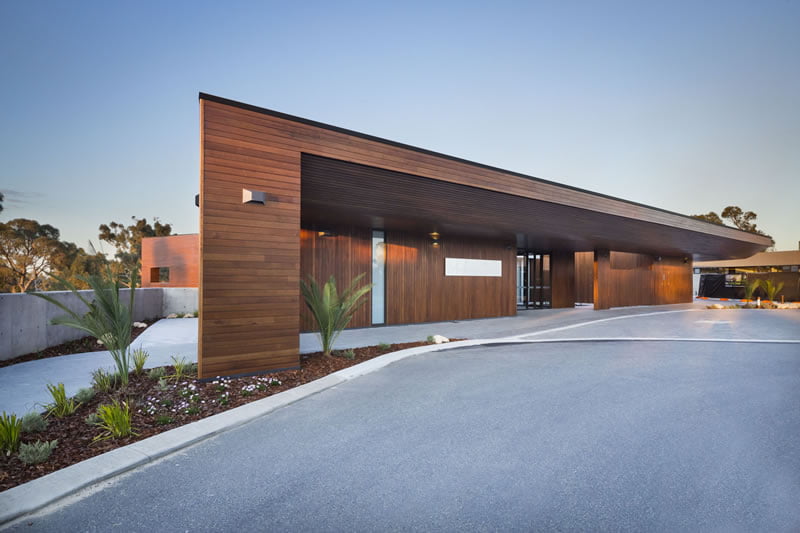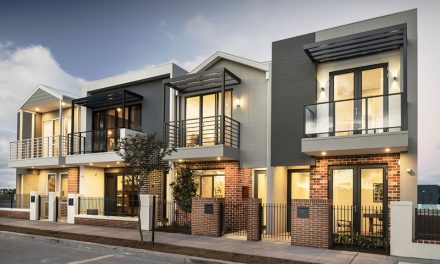Visually striking and great for the planet, timber cladding is enjoying its heyday.
If you want your home or business to stand out from the crowd, using a natural product like timber cladding is the perfect way to create a unique and stunning façade that will offer you a variety of benefits that stretch far beyond the aesthetic.
These days consumers are spoiled for choice, with timber cladding available in a wide variety of timber species that can be made to measure as far as the imagination can stretch.
“Cladding is a classic material that can be used in both traditional and contemporary buildings, providing a decorative and functional finish that is flexible in use on its own or in conjunction with other materials,” says Jacinta Colley, national account manager for Simmonds Lumber, who provide both chamfer and rusticated timber cladding products.
“Our customers typically choose our cladding because it offers a sustainable building option with a stunning timber look that creates warmth and depth in every project.”
Simmonds currently offer two styles of timber cladding – chamfer for Queensland and rusticated for other states, but can produce anything upon request. Simmonds’ rusticated hardwood cladding product is sourced through Parkside – Australia’s largest Spotted Gum hardwood sawmiller.
“Parkside timber products have Chain of Custody certification and are primarily sourced through the Queensland State Forestry,” Colley says. “Parkside’s quality of sawmilling and species used are second to none. Therefore Parkside’s cladding will stand the test of time when compared to cheaper alternatives. Spotted Gum particularly offers a unique colour and look that customers tend to love.”
A unique aesthetic appeal is also what draws customers to Australian Sustainable Hardwoods (ASH), who offers IRON ASH timber cladding, which is treated to H3 classification and has a 25-year guarantee externally against decay and termites.
“For an external cladding it’s one of the only timbers that are guaranteed to not rot within 25 years,” says Daniel Wright, ASH national marketing manager. “In full exposure on a west-facing wall – which is the worst that conditions could be – IRON ASH doesn’t need a coating and doesn’t need a regular maintenance regime, which is really unique. What it does need is the end grain sealed – with the end grain sealed it will stop moisture penetration in the ends, which prevents end splits, so if you do that and you’re prepared to let the timber grey off, it won’t decay and it won’t get attacked by termites, even without a maintenance regime, for 25 years.”
Another appeal that ASH cladding offers is the flexibility of creating the product to whichever dimensions customers require. They have a standard offering, which is the most cost-effective, off-the-shelf option, but they have the ability to customise anything.
“We’ve got the flexibility of creating custom profiles and shapes, so you can get a different three dimensional feel and you can play with light in the architecture of the façade,” says Daniel Wright, ASH national marketing manager. “An architect likes to play around with shapes of timber and its orientation in relation to the sun, so you can create shadows and shades. Aesthetics is one of the major reasons people choose our timber, because it looks good, but likewise, if they can have the sun and shade playing off against each other to create patterns on the wall then that can add extra character.
“Timber is pliable – you can make whatever shapes you like, and architects love to work with our cladding for that reason. It’s also cost-effective – one of the more cost-effective hardwoods. It’s durable, and it’s relatively dense but relatively lightweight.”
At the moment, ASH has the largest volume of hardwood in the one mill in Australia.
“We also have five manufacturing facilities onsite so we can produce everything in-house, Wright says. “What makes us stand apart is, of course, the timber itself,” Wright says, “In our case it’s a dense hardwood that is really stable and it is very straight and long, so quite easy to use, but it’s priced really affordably as well, as far as hardwoods go. But it’s our manufacturing ability that really keeps then coming back.”
Show your soft side
Not all timber cladding products available in Australia are made from hardwood. Outdoor Timber provide premium F7 grade White Cypress Pine chamfer and rusticated chamfer weatherboard cladding to wholesalers across eastern Australia. White Cypress is a highly durable Australian softwood, and one that Alison Gebbing, sales manager at Outdoor Timber, believes is underrated, especially as it is well-suited to exposed external applications.
“It’s such a beautiful product, and there are so many benefits to it,” Gebbing says. “I think a lot of people aren’t aware of its benefits. It’s naturally termite-resistant, it’s versatile, it’s durable – it doesn’t require any maintenance – and it has a really high heat resistance.
We get a lot of jobs specifying Cypress because of that fact – we had a lot when they were rebuilding after the Black Saturday fires.
“It’s one of those products that not enough people know about it.”
Simmonds also offers a softwood Radiata Pine chamfer cladding that is imported from Arauco.
Arauco was established 47 years ago to produce and manage renewable forest resources, and has become one of the largest forestry businesses in the world, not only in terms of forest surface and industrial facilities, but in terms of efficiency, production standards, innovation, environmental responsibility and social commitment. Arauco maintains over 30 production facilities in Chile, Argentina, Brazil, Uruguay, the United States and Canada, with a sales presence in over 80 countries servicing over 3500 customers through 220 ports worldwide.
“Radiata Pine is relatively lightweight and quick to install, sourced from both FSC and PEFC certified forests and requiring much less fossil fuels to manufacture than other types of cladding,” says Colley. “It can be used by itself to completely clad a building or in conjunction with brick, steel or concrete – you could say it becomes a feature on its own.”
Simmonds’ Radiata Pine cladding products are responsibly sourced, and Arauco is in constant dialogue with its neighbouring communities to seek out opportunities for increasing its contribution to local socioeconomic development in those areas.
“Over the years, the company has maximised the value of its forest plantations by conducting ongoing research and applying global best practices regarding long-term sustainability, while at the same time, protecting the native forests, land and biodiversity present in its forestland, for future generations,” Colley says. “All Arauco nurseries, plantations, harvesting, sawmilling, remanufacturing and treatments facilities are FSC and PEFC certified. It’s one of only a few global companies that can lay claim to total control from seedling to finished product.”
Super sustainable
For Michael Kennedy, CEO and founder of Kennedy’s Reclaimed and Sustainable Architectural Timbers, cladding is one of his biggest sellers.
“Timber cladding is certainly a very popular product, whether it’s for the exterior of a house or shop, or apartments or office buildings,” Kennedy says.
“Our cladding customers mostly use it for commercial projects – office fitouts, retail fitouts. But we’re increasingly seeing more cladding in residential fitouts, because of people watching design shows on TV where they use timber as feature walls and things like that – then we get people saying they want that in their home, because it offers a very unique look.”
It’s not just the look that many customers are after. Awareness is constantly growing about the sustainable nature of timber as a building product.
“The environmental benefit of using timber is a big one,” Kennedy says. “As we all know timber stores carbon, and the fact that it’s storing carbon means that you can clad a building with a very environmentally friendly product.
“Also if you choose the right timber it can last a very long time with very little maintenance.
A high durability timber like Ironbark or Spotted Gum or Blackbutt – those species are all highly durable. Doing nothing to them, they will last more than 30 years in an exposed application with no maintenance.”
Using recycled timber only adds to the sustainable nature of Kennedys’ offerings. The company sources timber from old bridges, warehouses and power poles, before cutting it up, removing any metal pieces and kiln-drying it.
As each piece of timber is different, there is also a great deal of flexibility when it comes to each customer’s individual design specifications.
“One of the great things about timber is that there are an infinite number of choices you can have in terms of colour, profile, width, thickness and finishes,” Kennedy says. “There would be more than 100 options in our range in terms of cladding alone.”
Kennedy’s now supplies recycled timber products nationally, and as far afield as New Zealand, China and Malaysia, with a lot of business coming from customer referrals.
“People are very savvy these days with their building projects,” Kennedy says. “The internet is a wonderful thing – you can go and search something and find suppliers, so the channel to market is a lot more direct than it’s ever been. You have end users being able to source products and get them direct from the supplier. And they can go and do a lot of homework before they even come and see you – they can look at their options and see what is out there and what they can do.”
Trend setting
As public awareness continues to grow about the sustainable nature of timber, will timber cladding continue to increase in popularity? Building design trends come and go, and right now timber cladding appears to be in its heyday.
“Right now it is quite fashionable to use timber cladding, as there are definitely more people wanting to use it at the moment,” Wright says. “Sustainability and the drive in the timber-built environment and all the benefits that timber offers is helping spearhead that.
“But there’s a potential downside to that – what we went through in the last fashion boom for timber cladding was a poor understanding of the way that timber ages, as well as its maintenance requirements. Educating people about this is an important role we in the industry can play.”
Of course, fashions come and go and that’s just the way fashions work. However, with the growing awareness of sustainable building practices and the understanding and awareness surrounding our environment, it’s likely that exposed timber applications like external cladding will continue to enjoy popularity in the years to come.
“It’s definitely a design trend – not just in Australia – a worldwide trend,” Kennedy says. “Years ago people used to clad all the old homes in timber weatherboard and paint them. Now people want to see the natural product so they put it up and don’t paint it – it’s being used in an exposed application, so people can see the beauty of timber.
“People want to use natural materials and materials that are environmentally friendly. Well, there’s nothing more natural and environmentally friendly as a building material than timber. Using timber is a very strong environmental choice; using recycled timber is a super strong environmental choice.
“I think the market will continue to grow. We’ll have different products and develop different applications and treatments. I think we’re going to see the cladding market and exposed timber growing in the future.”
For more information on Simmonds go to simmondslumber.com.au
For more information on ASH go to vicash.com.au
For more information on Outdoor Timber go to outdoortimber.com.au
For more information on Kennedy’s go to kennedystimbers.com.au









